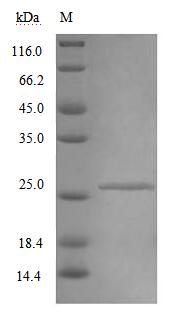Recombinant Mouse Interferon alpha/beta receptor 2 (Ifnar2) is produced in a yeast expression system and spans the extracellular domain from amino acids 22 to 242. The protein carries an N-terminal 6xHis-tag and shows purity levels exceeding 90%, as confirmed by SDS-PAGE analysis. This protein is intended strictly for research purposes and contains no detectable endotoxin, which appears to make it suitable for various experimental applications.
Interferon alpha/beta receptor 2 (Ifnar2) represents a critical component of the interferon signaling pathway. It likely plays a central role in mediating cellular responses to type I interferons. The protein participates in several cellular processes, including antiviral defense and immune response modulation. Its research significance stems from its involvement in immune regulation studies and host-pathogen interaction research.
Potential Applications
Note: The applications listed below are based on what we know about this protein's biological functions, published research, and experience from experts in the field. However, we haven't fully tested all of these applications ourselves yet. We'd recommend running some preliminary tests first to make sure they work for your specific research goals.
Based on the provided information, recombinant mouse Ifnar2 extracellular domain (22-242aa) is produced in a yeast expression system with an N-terminal 6xHis-tag. Yeast expression systems provide eukaryotic folding machinery capable of supporting disulfide bond formation and glycosylation, which are critical for the structural integrity and function of interferon receptor extracellular domains. The defined "Extracellular Domain" region suggests the construct is designed to include the functional ligand-binding portion of Ifnar2. However, as a soluble fragment lacking the transmembrane and intracellular domains, it may not fully replicate the conformational constraints of the membrane-bound receptor. Purity >90% by SDS-PAGE under denaturing conditions does not confirm native folding or bioactivity. No validation data (e.g., interferon binding assays, circular dichroism) are provided. Therefore, while yeast expression increases the probability of correct folding, the protein's structural and functional integrity cannot be guaranteed without experimental validation.
1. Interferon Receptor Binding Studies
If correctly folded, this recombinant Ifnar2 extracellular domain could be used to study interferon binding interactions using techniques like surface plasmon resonance. However, the His-tag may sterically hinder the binding interface or alter conformation, potentially affecting affinity measurements. If misfolded, binding studies would yield biologically irrelevant data. Validation of folding and direct comparison with tag-free protein are essential for reliable results.
2. Antibody Development and Characterization
This application is suitable, as antibody generation primarily relies on linear epitope recognition. The extracellular domain provides relevant epitopes for antibodies targeting the receptor's functional region. However, if misfolded, antibodies may not recognize conformational epitopes critical for blocking interferon binding in native receptors.
3. Protein-Protein Interaction Analysis
If properly folded, the protein could identify interaction partners, but the soluble extracellular domain may lack context-dependent interactions present in full-length membrane receptors. If misfolded, pull-down assays may capture non-specific binders. Interactions should be validated with full-length receptors in cellular contexts.
4. Structural and Biophysical Characterization
If correctly folded, structural studies are feasible, but the His-tag should be removed to avoid interference. If misfolded, structural data would misrepresent the native receptor. Biophysical analyses must be interpreted cautiously, as solution properties may differ from membrane-bound states.
Final Recommendation & Action Plan
This yeast-expressed Ifnar2 extracellular domain has a reasonable chance of proper folding but requires validation before functional applications. Implement the following: 1) Confirm folding via circular dichroism (secondary structure) and size-exclusion chromatography ( oligomeric state); 2) Validate bioactivity using interferon binding assays with positive controls; 3) For critical binding/interaction studies, remove the His-tag proteolytically and compare with tagged protein; 4) Use antibody development applications immediately, but validate antibodies against native cellular Ifnar2. If validation fails, consider mammalian-expressed extracellular domains for higher physiological relevance.






